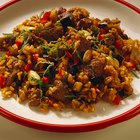
Cornstarch and rice flour are both suitable thickening agents for soups, gravies and other dishes. While they have slightly different functions and uses, they both are capable of thickening a sauce to perfection when used appropriately. While rice flour is slightly more versatile, as it can be used both as a roux or slurry, cornstarch's use is limited to slurry for thickening purposes. Consider your needs and select accordingly to ensure your sauce, soup or gravy turns out rich and delicious.
Features of Thickening Agents
Cornstarch is produced from corn and is most suitable for sauces that will not need to be boiled or frozen after its addition. It also has a slightly white color, which makes it inappropriate for thickening a clear liquid that needs to stay clear. Rice flour is highly versatile and more similar to white flour than cornstarch. It can be used to make a roux or slurry and is more stable at high and low temperatures than cornstarch.
Using Cornstarch
Cornstarch is used to thicken soups and sauces by creating a slurry. It must first be blended with cold water to prevent clumping in the finished product. Whisk one part cornstarch with four parts cold water until the two are incorporated. Add one cup of hot liquid from your soup or sauce and mix well to form the slurry. Pour this slurry back into the soup or sauce and stir well. Do not let a sauce with cornstarch boil, as this will reverse cornstarch's thickening abilities. Avoid using cornstarch in acidic foods, as the acid prevents cornstarch from acting as a thickener.
Using Rice Flour
Rice flour can be substituted in equal proportion for a recipe calling for white flour for thickening. Use it either mixed in with vegetables and oil to form a roux or as a slurry at the end of preparation. Rice flour does not clump as much as cornstarch when creating a slurry and can be initially mixed with hot or cold liquids to blend before adding back into your recipe. Unlike cornstarch, rice flour produces no noticeable color, making it a good choice for thickening clear liquids.
Cornstarch and Rice Flour Uses
Cornstarch and rice flour are widely used in cooking as thickeners because they are gluten-free. Using these items in cooking allows many people with gluten sensitivities to eat food that they would otherwise be unable to when thickened with the more traditional white flour in American cooking. Beyond its use as thickening agents, cornstarch is used widely to help tenderize meat and coat it for deep frying and pan frying. Rice flour is used to make gelatinous dumplings and as a coating for deep frying.
Related Articles
Can You Substitute Cornstarch for Flour?

Do You Use Flour or Corn Starch to ...

Substitute for Manioc Starch

Differences Between Steamed & Boiled ...

What Can I Substitute for Cornstarch?

How to Cook Couscous With Chicken Broth
Are Masa & Fine Cornmeal Used for ...

Tapioca Flour Vs. Quick Cooking Tapioca

What Else Could You Use Besides Cream ...

Can I Use Baking Powder to Thicken ...

How to Cook Brown Basmati Rice

Can You Use Matzo Flour to Thicken ...

Brown Basmati Rice Cooking Directions

How to Boil Rice

Can You Use Konjac Flour in Baking?
What Can I Substitute for Cornstarch?

How to Make Your Own Rice Milk

Nutrition Value of Corn Meal

How Long After a Sell-By Date Can You ...

How to Make French Sauce With Roux of ...
References
- The Japanese Kitchen; Hiroko Shimbo
- The New Best Recipe; America's Test Kitchen
Writer Bio
Based in Portland, Ore., Maxine Wallace is a writer with more than 12 years of experience. With a bachelor's degree in journalism and experience working on marketing campaigns for large media agencies, she is well-versed in multiple industries including the Internet, cooking, gardening, health, fitness, travel and holistic living.
Photo Credits
PhotoObjects.net/PhotoObjects.net/Getty Images